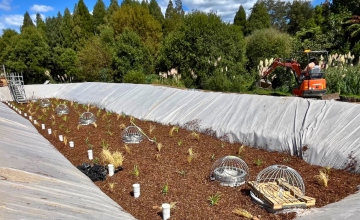LittaTrap demonstrates high litter and sediment removal
7 March 2018
In December 2017, the LittaTrap was independently tested in Toronto, Canada at Good Harbour Laboratories. This innovative catchpit insert from Stormwater360 was tested for sediment efficiency, gross pollutant capture and scour potential.
The testing protocol was based on a combination of the New Jersey Dept. of Environmental Protection (NJDEPT), Canadian Environmental Technology Verification (CETV) and Californian Transport Authority (Caltrans).
These protocols are used to certify the performance of treatment devices in North America in meeting regulatory requirements.
The first test to understand sediment removal efficiency used a standardised synthetic stormwater sediment to evaluate removal rates.
The test sediment was the standard test sediment under the Canadian ETV and New Jersey Manufactured Treatment Device protocols. The test sediment is very fine with a d50 of 75 microns with no particles over 1mm.
In the test, the LittaTrap removed over 50% of the suspended sediment. Inflow into the catchpit is directed onto the LittaTrap, which dissipates the energy of the incoming water and distributes the flow across the entire surface area of the sump. This increases the settling ability of the existing catchpit sump and the LittaTrap captures this fine sediment in the sump of the catchpit.
 Inlet End of Streetscape
Inlet End of Streetscape
Catch Basin End of Streetscape
By removing over 50%, the LittaTrap qualifies as a pre-treatment device with equivalent performance to end of pipe Hydrodynamic Separators and Gross Pollutant Traps.
Testing also included evaluating the system for wash-out or scour in large or more extreme rainfall events. The objective of this test was to quantify and characterise the amount of previously captured sediment that can be re-suspended and washed out during periods of high flow.
For treatment devices to be placed online they must not release more than the average 20mg/l at 200% of its treatable flow rate. For this test, the sump of the catchpit was filled to 50mm below the outlet with test sediment. This is the suggested maintenance depth of the sump with a LittaTrap installed. The flow rate through the system was gradually increased over the test to a maximum of 15.6 l/sec. The average released concentration was 7.8-mg/ l.

Sediment Pre-loading of Sump
The final test conducted on the LittaTrap was the Trash Test. This performance test assessed the LittaTrap’s ability to remove gross pollutants from stormwater runoff and evaluates the systems clogging capability and hydraulic performance. This test is based on work reported in the Caltrans document “Laboratory Testing Of Gross Solids Removal Devices “.
Synthetic gross pollutants were added to the testing runoff and included paper, plastic sheets, cloth and plastic film contaminants that can easily stick to a screen and cause a system to 'blind.'
In this test, the LittaTrap caught 99.4% of the gross solids @ 15 l/sec in a test that lasted over 1 hour.
While originally developed to be an ‘Easy to Maintain, Low-Cost Solution’ to trap plastics at the source, these results show the LittaTrap also greatly enhances the performance of the catchpit to a level where it is equivalent to a Gross Pollutant Trap in removing fine suspended solids.
The LittaTrap is an ideal solution for pre-treatment and to retrofit into existing urban catchments and is an affordable option for any catchpit owner.
For more information contact [email protected] or 0800STORMWATER
The only other New Zealand catchpit insert that has undergone such rigorous and scientific testing is the Stormwater360 EnviroPod, which shows our continued dedication to true, independent, scientific evaluation to international standards.



